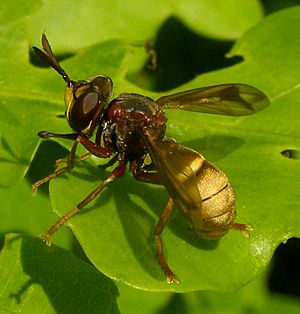List of conopid fly species of Great Britain facts for kids
Welcome to the world of Conopid flies! These amazing insects are also known as "thick-headed flies" because of their often large heads. They are a special type of fly found all over the world, and many of them look a lot like bees or wasps, even though they are harmless flies. This article lists the different kinds of Conopid flies that have been found living in Britain.
Conopid flies are known for their interesting life cycle. Many species are parasites of other insects, especially bees, wasps, and even grasshoppers. This means the young fly (larva) grows inside the body of another insect, which helps control the populations of those insects in nature.
Contents
Discovering Conopid Flies in Britain
Scientists group living things into different families and groups to understand them better. Conopid flies belong to a family called Conopidae. Within this family, there are smaller groups called subfamilies, and even smaller groups called tribes. Each tribe contains different genera (plural of genus), and each genus contains different species. Think of it like a big family tree!
Meet the Conopinae Family
The Conopinae are one of the main groups of Conopid flies. They often have long, slender bodies and can be quite colourful.
The Conopini Tribe: Masters of Mimicry
Flies in the Conopini tribe are often very good at pretending to be other insects. This helps them stay safe from predators.
- Genus Conops (named by Carolus Linnaeus in 1758)
-
- Subgenus Conops (also named by Carolus Linnaeus in 1758)
-
- Conops ceriaeformis (discovered by Johann Wilhelm Meigen in 1824)
- Conops flavipes (discovered by Carolus Linnaeus in 1758)
- Conops quadrifasciatus (discovered by Charles De Geer in 1776)
- Conops strigatus (discovered by Christian Rudolph Wilhelm Wiedemann in 1824)
- Conops vesicularis (discovered by Carolus Linnaeus in 1761)
- Genus Leopoldius (named by Camillo Rondani in 1843)
-
- Leopoldius brevirostris (discovered by Germar in 1827)
- Leopoldius signatus (discovered by Christian Rudolph Wilhelm Wiedemann in 1824)
The Physocephalini Tribe: Unique Shapes
Flies in the Physocephalini tribe often have distinct head shapes and body patterns.
- Genus Physocephala (named by Ignaz Rudolph Schiner in 1861)
-
- Physocephala nigra (discovered by Charles De Geer in 1776)
- Physocephala rufipes (discovered by Johan Christian Fabricius in 1781)
Exploring the Myopinae Family
The Myopinae are another important subfamily of Conopid flies. They can look quite different from the Conopinae, sometimes being smaller or having different wing patterns.
The Myopini Tribe: Diverse and Widespread
The Myopini tribe includes many different species that can be found in various habitats across Britain.
- Genus Myopa (named by Johan Christian Fabricius in 1775)
-
- Myopa buccata (discovered by Carolus Linnaeus in 1758)
- Myopa extricata (discovered by James Edward Collin in 1960)
- Myopa fasciata (discovered by Johann Wilhelm Meigen in 1804)
- Myopa occulta (discovered by Christian Rudolph Wilhelm Wiedemann in 1824)
- Myopa polystigma (discovered by Camillo Rondani in 1857)
- Myopa strandi (discovered by Oswald Duda in 1940)
- Myopa tessellatipennis (discovered by Motschulsky in 1859)
- Myopa testacea (discovered by Carolus Linnaeus in 1767)
- Myopa vicaria (discovered by Walker in 1849)
- Genus Thecophora (named by Camillo Rondani in 1845)
-
- Thecophora atra (discovered by Johan Christian Fabricius in 1775)
- Thecophora fulvipes (discovered by Jean-Baptiste Robineau-Desvoidy in 1830)
The Sicini Tribe: Lesser Known Species
The Sicini tribe contains a few interesting species of Conopid flies.
- Genus Sicus (named by Pierre André Latreille in 1796)
-
- Sicus abdominalis (discovered by Otto Kröber in 1915)
- Sicus ferrugineus (discovered by Carolus Linnaeus in 1761)
The Zodionini Tribe: Small but Mighty
Flies in the Zodionini tribe are often smaller, but they play an important role in their ecosystems.
- Genus Zodion (named by Pierre André Latreille in 1796)
-
- Zodion cinereum (discovered by Johan Christian Fabricius in 1794)
- Zodion notatum (discovered by Johann Wilhelm Meigen in 1804)


